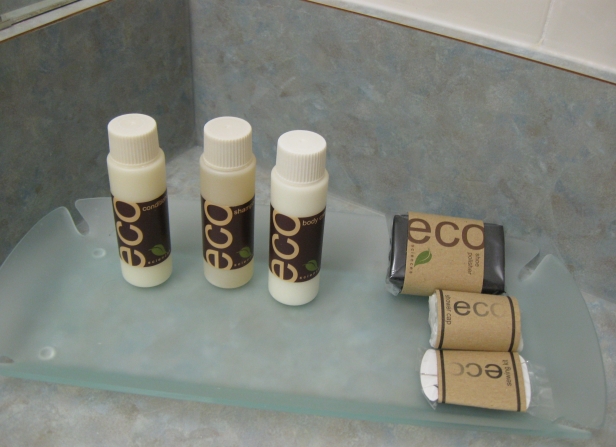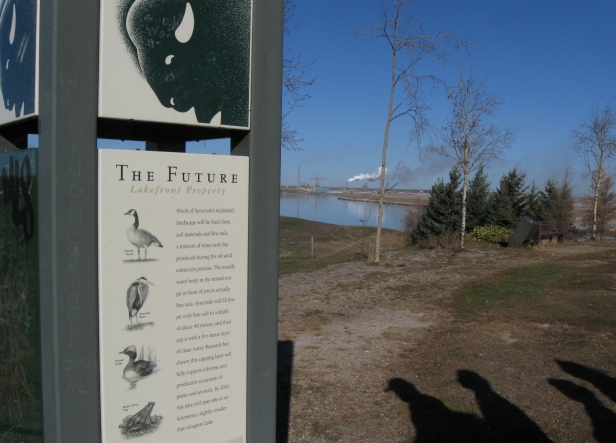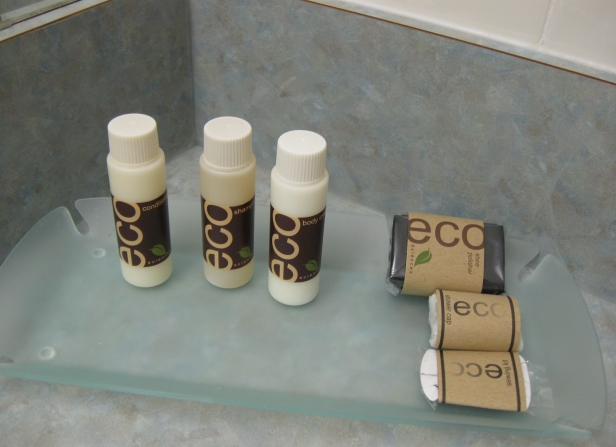This is my third post from the tar sands. Previously, a look at the boomtown of Fort McMurray and a helicopter ride above the mines.
 Energy execs can scrub their consciences clean with this “eco” shampoo.Photo: Jonathan HiskesSay you’re an energy executive from Houston or Edmonton, Alberta, staying at the biggest hotel near the Canada tar sands, helping your company reap profits from the largest oil excavation project on the planet.
Energy execs can scrub their consciences clean with this “eco” shampoo.Photo: Jonathan HiskesSay you’re an energy executive from Houston or Edmonton, Alberta, staying at the biggest hotel near the Canada tar sands, helping your company reap profits from the largest oil excavation project on the planet.
It’s dirty business — producing usable petroleum from the black muck here requires three to four times the greenhouse-gas emissions of conventional drilling, plus two to four barrels of water per barrel of oil, the remains of which are fed into tailings ponds.
So you’ll be glad to know that the hotel bathroom toiletries come in “eco” packaging — biodegradable shampoo and conditioner bottles and recycled-paper wrappers for the shower cap and shoe polisher. It’s the little things that add up, see? We all must do our part to protect the planet, starting with our toiletries.
At least I assume that’s the thinking. I was reminded of that creative logic when I visited a “reclaimed” forest near the miles and miles of open-pit mines. The public-relations efforts of tar-sands companies (which get much more attention in Canada than in the U.S.) center on a pledge to “reclaim” the tracts of boreal forest they’ve disrupted. But they’re not restoring what was previously there. They’re replacing the natural muskeg — a soupy, boggy wetland — with dry infill planted with seedlings, a very different landscape. No one’s figured out how to re-create muskeg.
But who am I to say what’s an ecological problem and what’s merely a marketing challenge? At the edge of the reclaimed forest, near a buffalo reserve, an unintentionally hilarious sign heralds “The Future: Lakefront Property.” After the waste ponds have reached a depth of 40 meters (workers build berms of waste sand to contain them), Suncor will top off the toxic water with five meters of clean water. That’s enough, the sign says, for a “diverse and productive ecosystem of plants and animals.”
 “Lakefront property” that Suncor promises to restore near its tailings pond and upgrader plant.Photo: Jonathan Hiskes
“Lakefront property” that Suncor promises to restore near its tailings pond and upgrader plant.Photo: Jonathan Hiskes
The Suncor upgrader facility puffs out steam beyond the pond. Air cannons pop every few seconds to ward off birds that might mistake the ponds for, well, water, and get stuck in the yogurt-like goop (this happened to 500 ducks two years ago).
There are steps tar-sands companies could take to make their work relatively cleaner — and I applaud groups like ForestEthics and the Pembina Institute that are pushing them in that direction. But it’s still oil they’re producing. And the waste they’re dumping into ponds is still toxic. Cleaning up their reputation is going to take more than creative signage and biodegradable shampoo bottles.



